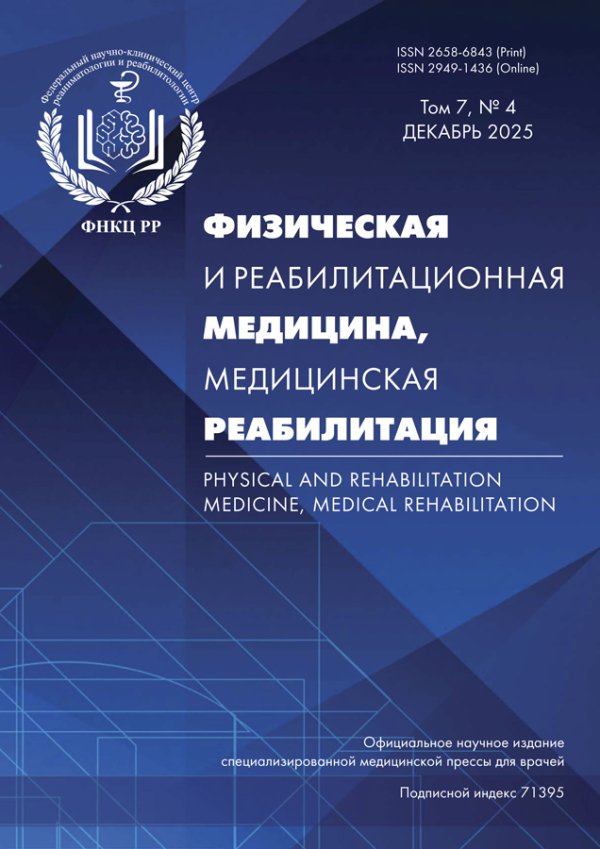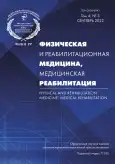Features of clinical reasoning in physical rehabilitation
- Authors: Zverev Y.P.1, Builova T.V.1,2
-
Affiliations:
- Lobachevsky State University of Nizhni Novgorod
- Union of Rehabilitologists of Russia
- Issue: Vol 4, No 3 (2022)
- Pages: 210-218
- Section: Technical Report
- URL: https://journal-vniispk.ru/2658-6843/article/view/109897
- DOI: https://doi.org/10.36425/rehab109897
- ID: 109897
Cite item
Full Text
Abstract
The article is devoted to the analysis of the clinical reasoning of specialists in the field of physical rehabilitation, in particular, specialists in physical therapy and occupational therapy. Despite numerous studies, the topic of "formation of clinical thinking" remains insufficiently studied and has its own peculiarities in the field of physical therapy.
The key features influencing clinical reasoning in physical rehabilitation are revealed. They include the use of movement as one of the main means of diagnosis, rehabilitation, evaluation of effectiveness, as well as the goals of rehabilitation interventions; focus on patient activity and participation (according to the International Classification of Functioning, ICF); patient mobility; interactivity and multidisciplinarity. The autonomy extend in professional activity has a significant impact on the formation of clinical reasoning of specialists.
Conceptually, clinical reasoning in physical rehabilitation may be defined as the combination and interaction of cognitive, affective and psychomotor skills. At the same time, effective clinical reasoning is narrative, adaptive and collaborative, contextual and it utilizes a biopsychosocial approach to the patient.
Keywords
Full Text
##article.viewOnOriginalSite##About the authors
Yuriy P. Zverev
Lobachevsky State University of Nizhni Novgorod
Author for correspondence.
Email: yzverev@yahoo.com
ORCID iD: 0000-0003-4477-748X
SPIN-code: 1793-4555
MD, Cand. Sci. (Med.), Assistant Professor
Russian Federation, Nizhny NovgorodTatyana V. Builova
Lobachevsky State University of Nizhni Novgorod; Union of Rehabilitologists of Russia
Email: tvbuilova@list.ru
ORCID iD: 0000-0003-0282-7207
SPIN-code: 6062-2584
MD, Dr. Sci. (Med.), Professor
Russian Federation, Nizhny Novgorod; MoscowReferences
- Huhn K, Gilliland SJ, Black LL, et al. Clinical reasoning in physical therapy: a concept analysis. Phys Ther. 2018;99(4):440–456. doi: 10.1093/ptj/pzy148
- Ivanchuk OV, Ganina OG. The clinical reasoning, clinical judgment phenomenon is one of the basic research definition. Modern Problems Sci Education. 2018;(5):1–8. (In Russ).
- Higgs J, Jones MA. Clinical reasoning in the health professions. In: Higgs J, Jones MA, editors. Clinical Reasoning in the Health Professions. 2nd ed. Boston, Mass: Butterworth-Heinemann; 2000. Р. 3–14.
- Gilliland S, Wainwright SF. Patterns of clinical reasoning in physical therapist students. Phys Ther. 2017;97(5):499–511. doi: 10.1093/ptj/pzx028
- Edwards I, Jones M, Carr J, et al. Clinical reasoning strategies in physical therapy. Phys Ther. 2004;84(4):312–330.
- Coderre S, Jenkins D, McLaughlin K. Qualitative differences in knowledge structure are associated with diagnostic performance in medical students. Adv Health Sci Educ Theory Pract. 2009;14(5): 677–684. doi: 10.1007/s10459-008-9149-8
- Christensen N, Black L, Jensen GM. Physiotherapy clinical placements and learning to reason. In: Higgs J, Sheehan D, Baldly Currens J, et al., editors. Realising exemplary practice-based education. Rotterdam: Sense Publishers; 2013. Р. 135–142.
- Driver C, Kean B, Oprescu F, et al. Knowledge, behaviors, attitudes and beliefs of physiotherapists towards the use of psychological interventions in physiotherapy practice: a systematic review. Disabil Rehabil. 2017;39(22):2237–2249. doi: 10.1080/09638288.2016.1223176
- Cott C, Finch E, Gasner D, et al. The movement continuum theory of physical therapy. Phy Canada. 1995;47(2):114–122.
- Jensen GM. Learning what matters most. Phys Ther. 2011; 91(11):1674–1689. doi: 10.2522/ptj.2011.mcmillan.lecture
- Magnusson DM, Zachary D, Rethorn ZD, et al. Population health, prevention, health promotion, and wellness competencies in physical therapist professional education: results of a modified Delphi study. Phys Ther. 2020;100(9):1645–1658. doi: 10.1093/ptj/pzaa056
- Rotor ER, Capio CM. Clinical reasoning of Filipino physical therapists: experiences in a developing nation. Physiother Theory Pract. 2018;34(3):181–193. doi: 10.1080/09593985.2017.1390802
- Jarodzka H, Boshuizen HP, Kirschner PA. Cognitive skills in medicine. In: Lanzer P, editor. Catheter-based cardiovascular interventions. Berlin: Springer-Verlag; 2013. Р. 69–86.
- Tricia Р. Use of the dual-processing theory to develop expert clinical reasoning in physical therapy students. J Phys Ther Ed. 2018;32(4):355–359. doi: 10.1097/JTE.0000000000000062
- Sebelski CA, Hoogenboom BJ, Hayes AM, et al. The intersection of movement and clinical reasoning: embodying “body as a teacher” to advance the profession and practice. Phys Ther. 2020;100(2): 201–204. doi: 10.1093/ptj/pzz137
- Jensen GM, Nordstrom T, Mostrom E, et al. National study of excellence and innovation in physical therapist education: part 1 ― design, method, and results. Phys Ther. 2017;97(9):857–874. doi: 10.1093/ptj/pzx061
- Wainwright SF, Shepard KF, Harman LB, et al. Factors that influence the clinical decision making of novice and experienced physical therapists. Phys Ther. 2011;91(1):87–101. doi: 10.2522/ptj.20100161
- Trowbridge RL, Rencic JJ, Durning S. Teaching Clinical Reasoning. Philadelphia, PA: American College of Physicians; 2015.
Supplementary files








